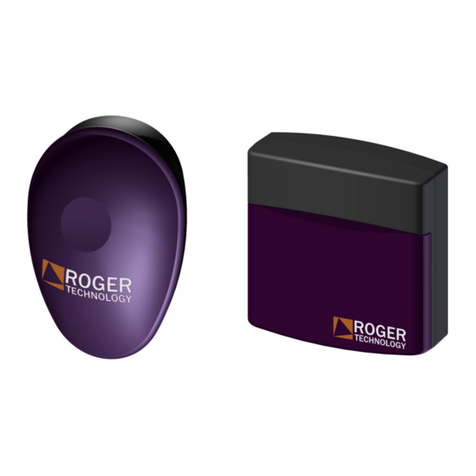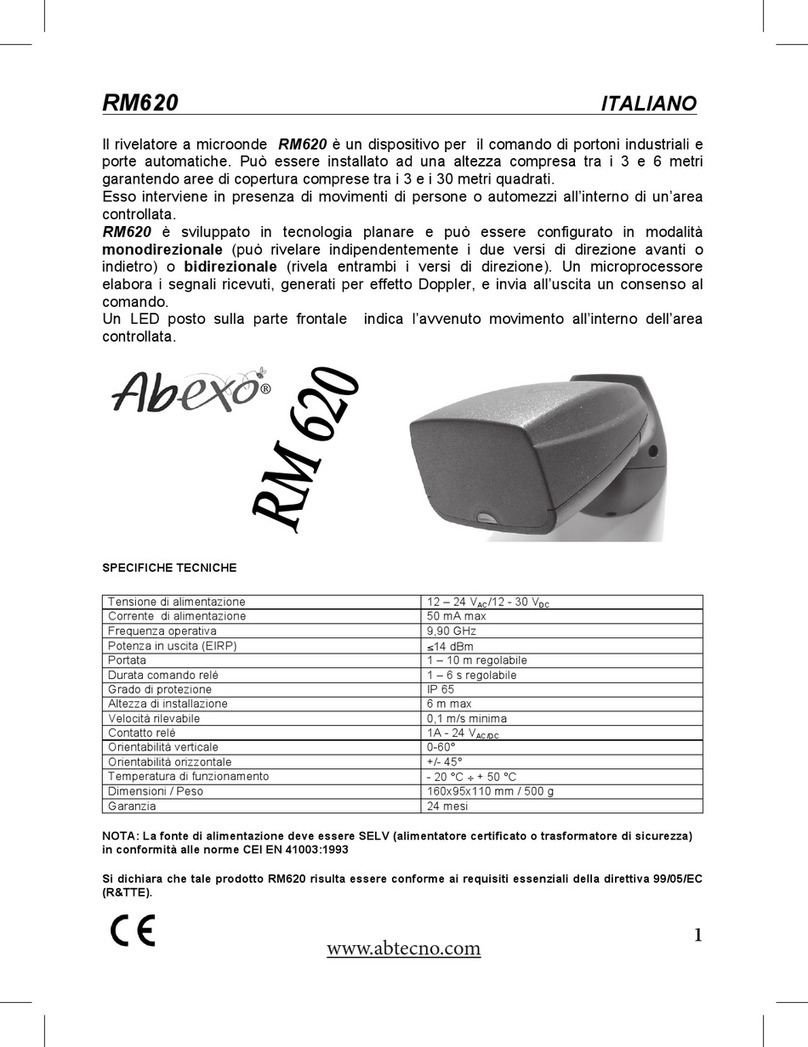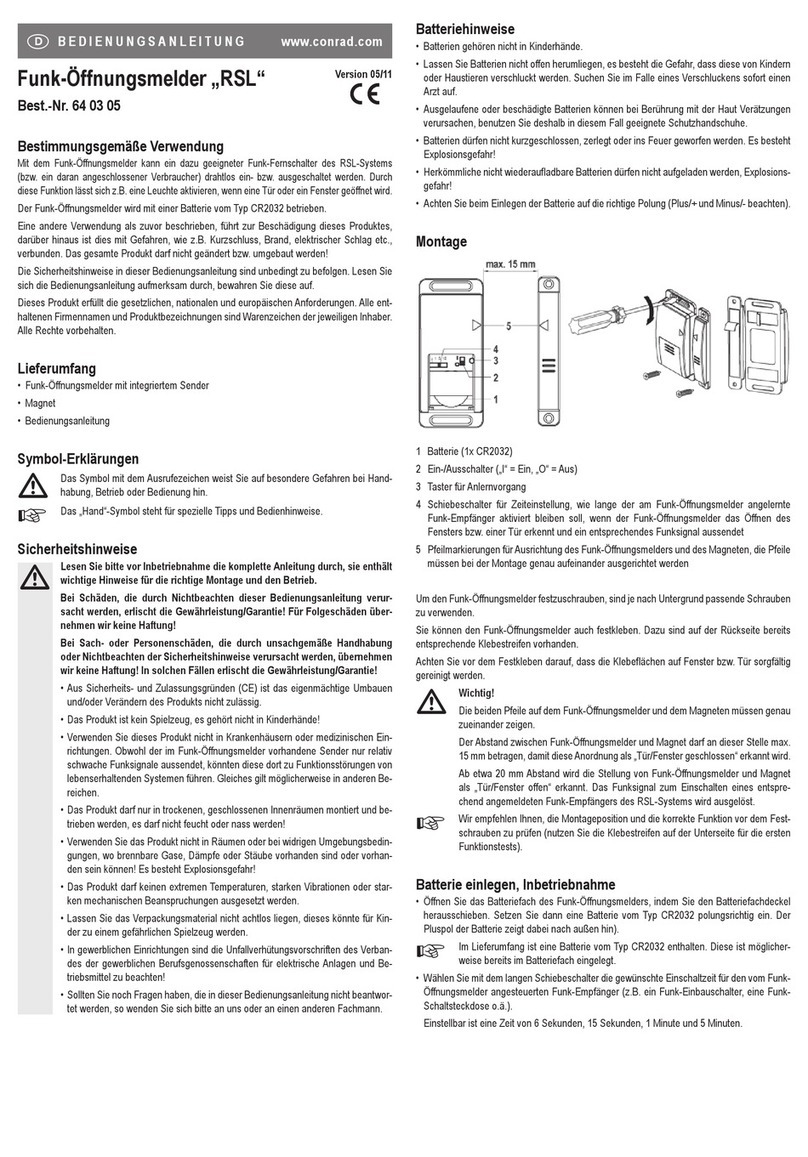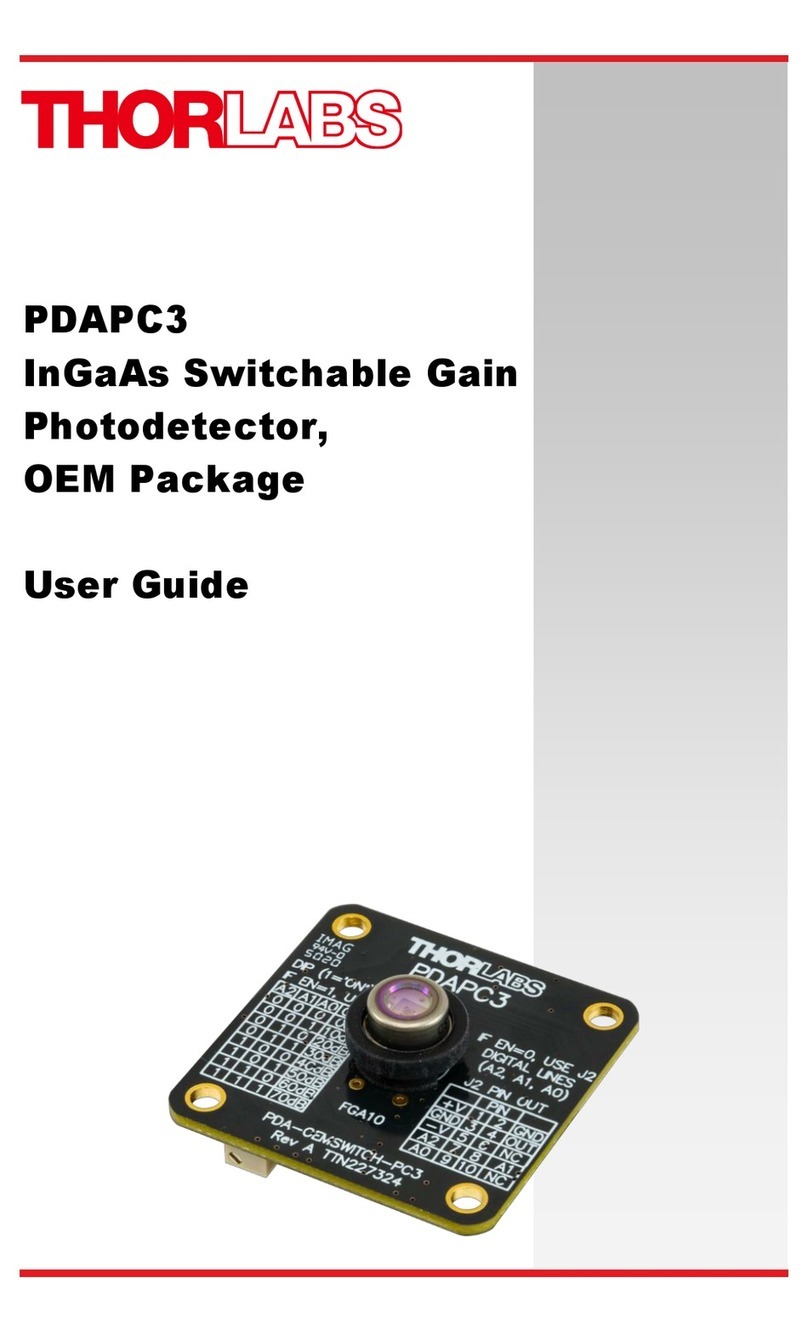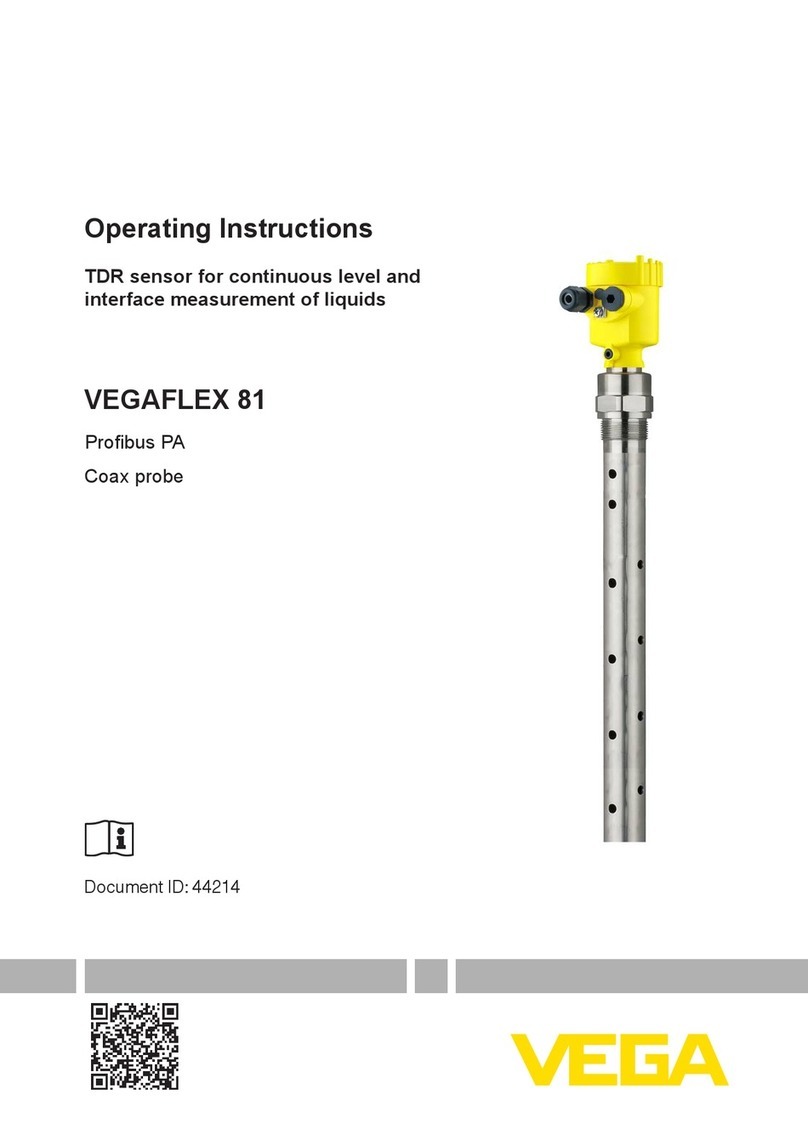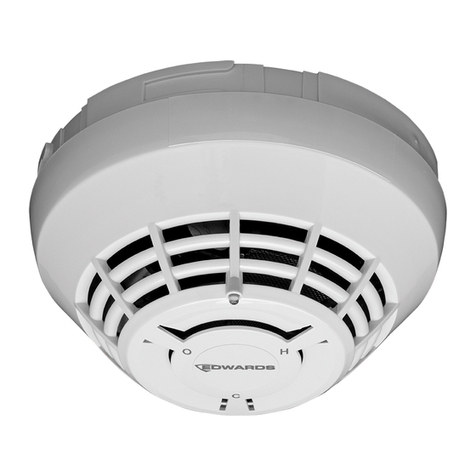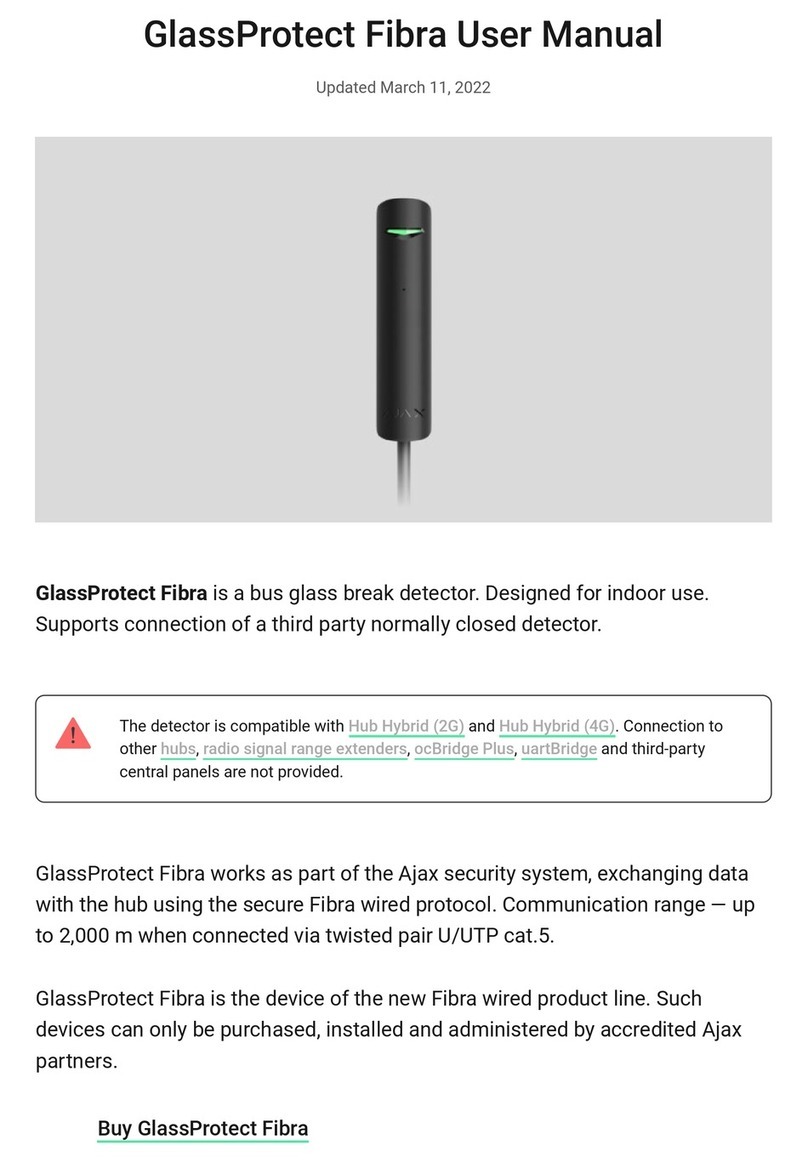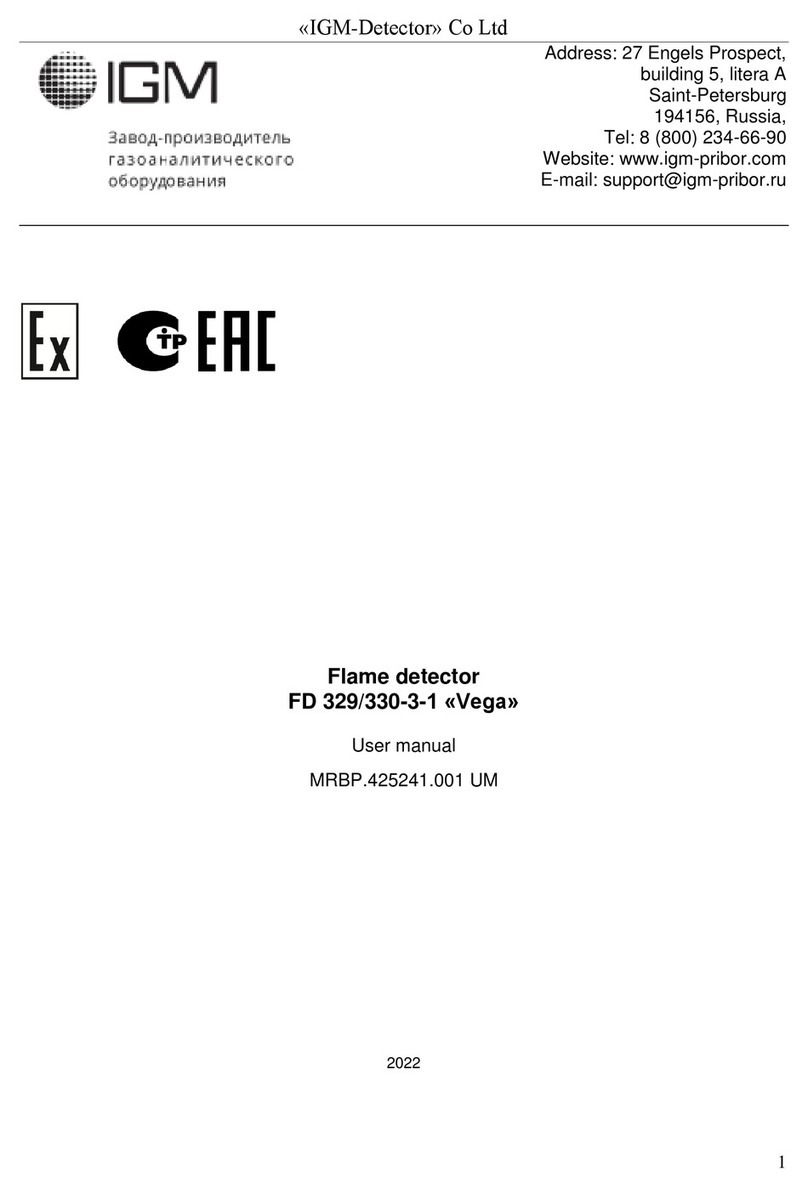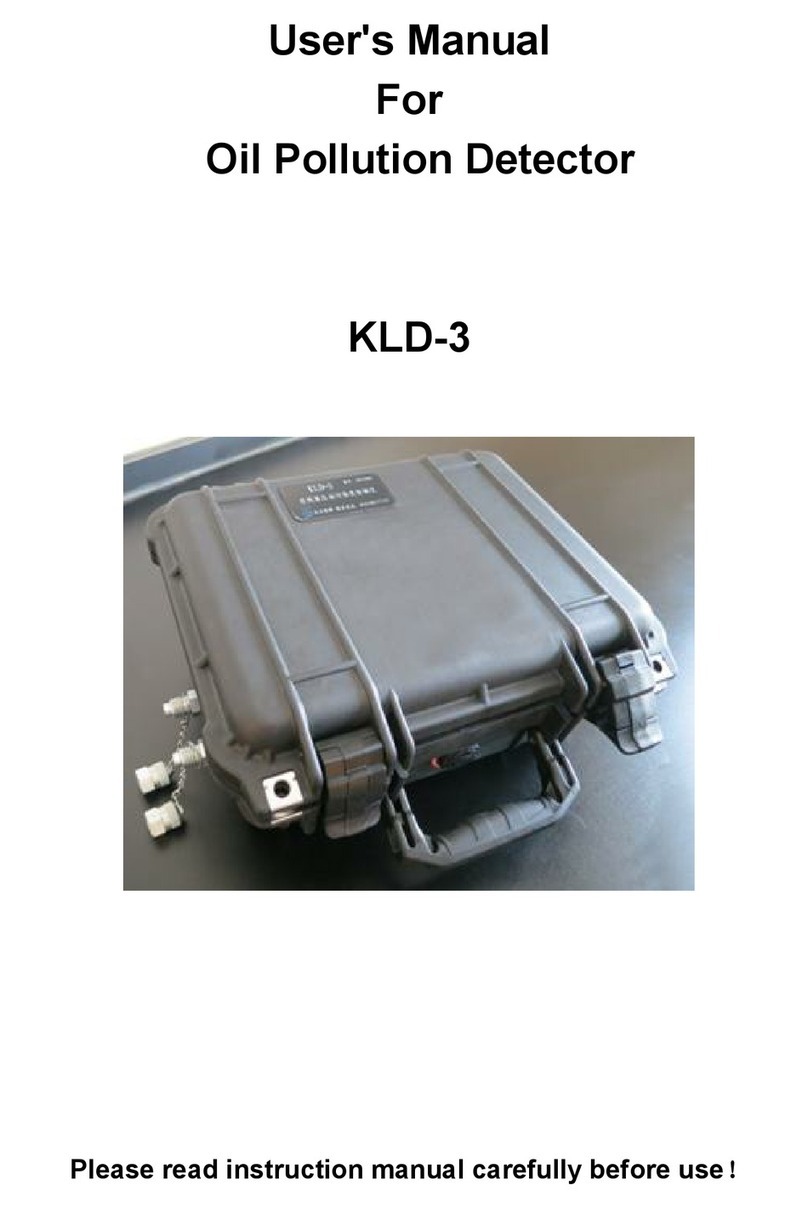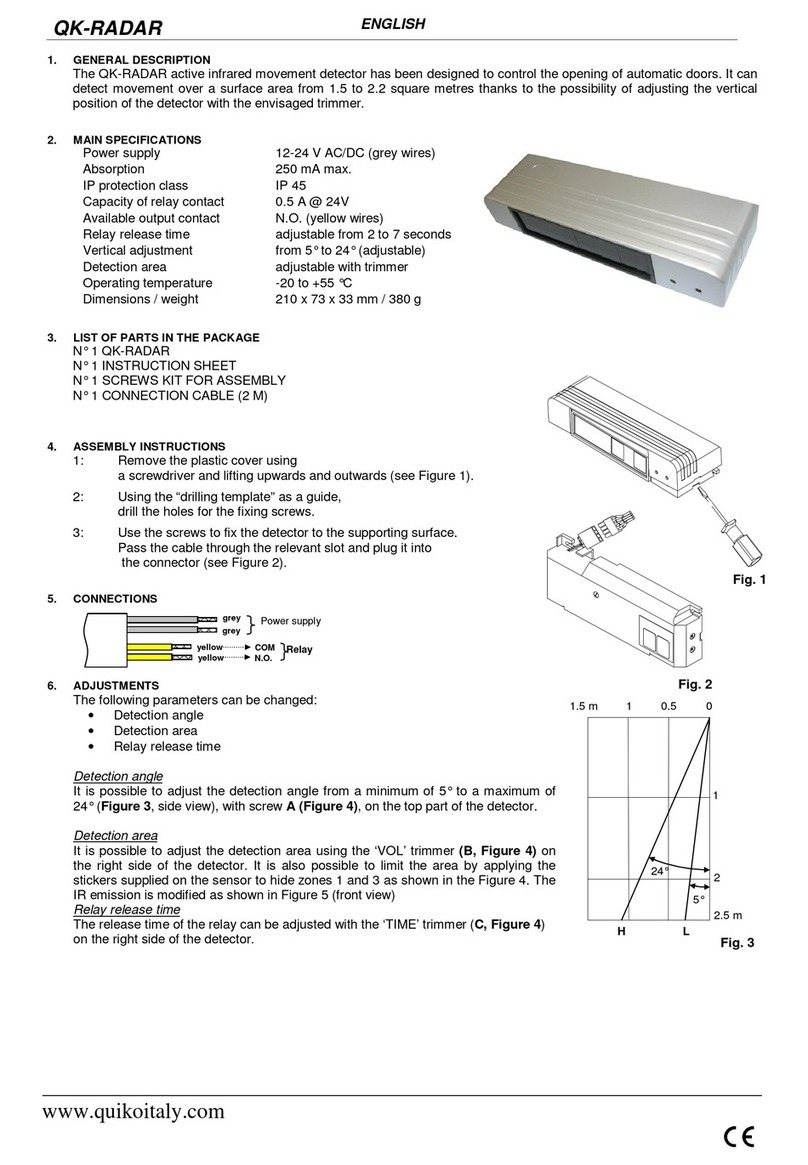Roger G90/F4ES User manual

ROGER PHOTOCELLS
G90/F4ES
Instrucon and warnings for the installer
|
IS61 Rev.04
10/05/2015

6
EN
1 Introducon to the instrucons and
warnings
This manual is intended only for qualified technical
installaon personnel.
No informaon contained herein may be considered of
interest to the end user.
This manual refers to synchronizable photocells R90/F4ES
and G90/F4ES and should not be used for other products.
Read the instrucons carefully before installing.
The installaon must be performed only by qualified
technical personnel in accordance with relevant legislaon.
Perform connecons with cables that are adequate to the
current and voltage requirements and comply with the
product specificaons.
In order not to affect their proper funconing, the
photocells must be properly aligned without using
reflecons and must not interfere with other photocells,
whether they be of the same or of different types. It is
possible in fact, to encounter interference between pairs
of not-synchronized photocells, including more than four
pairs of synchronized photocells or other devices that emit
infrared light. Take all the necessary precauons in order
to eliminate this problem.
To understand the issues related to reflecon and
interference between unsynchronized pairs see figure 2.
CAUTION: If the installaon requires a distance between TX
and RX of less than 2.5 meters, then the TX and RX lenses
must be removed: otherwise their proper funconing
cannot be guaranteed. Whatever the case, the minimum
distance allowed is 80 cenmetres.
WARNING: It is essenal to change the configuraon of the
jumpers when in the absence of voltage since they are only
read upon ignion and to prevent damage to components.
ATTENTION: in case of AC power supply, connect all TX and
RX with the same polarity.
WARNING
2 Product descripon
The synchronized photocells versions R90/F4ES and G90/
F4ES are presence detectors that use infrared technology,
which allow for the detecon of obstacles in the opcal
axis between the transmier and receiver photocells, they
can be used for automac entrances, for courtesy services
and monitoring passageways.
Synchronizaon allows you to connect up to 4 pairs of
photocells without worrying that they may interfere with
each other. Synchronizaon is accomplished through
an addional wire that connects all the photocells
transmiers and receivers.
Synchronizaon is achieved with a photocell TX, called
MASTER, and is transmied to the receiver coupled to it
and to all the other pairs of photocells available (called
SLAVE).
For these instrucons, the transmier photocell is called
TX photocell, the receiver photocell is called the RX
photocell, while one or more pairs of photocells (always
composed of an RX and a TX photocell) will be referred to
as photocells.
These photocells are intended for installaon on mounng
surfaces that are flat and parallel to each other, which
enable proper centring between the TX and the RX
photocells.
Available versions:
• R90/F4ES
• G90/F4ES
• G90/F4ES/TRIX/TX and G90/F4ES/TRIX/RX are
designed only for installaon on the column TRIX series.
1 Introducon to the instrucons and warnings 6
2 Product descripon 6
3 Technical Specificaons of the Product 7
4 Terminals and signalling 7
5 Installaon 7
5.1 Mounng 7
5.2 Wiring 8
5.3 Configuraon and alignment 8
5.4 Container Closure 8
6 Tesng 8
7 Maintenance 9
8 Disposal 9
9 Declaraon of conformity 9
10 Pictures and schemes 26
TABLE OF CONTENTS Page

7
3 Technical Specificaons of the Product
TECHNOLOGY Acve infrared, with modulated transmission controlled by a
microcontroller
POWER SUPPLY 24Vac 50Hz, 24Vdc
CURRENT CONSUMPTION TX=18mA, RX=27mA
WAVELENGTH
INFRARED EMISSION
950 nm
ANGLE OF DIODE EMISSION <17°
OPERATIONAL DISTANCE Standard 10m, opon 15m (cung bridge E from the RX photocell, see figure
11). Minimum operaonal distance of 0.8m
OUTPUT CONTACT Double relay with series connecons (double safe), normally closed output,
30Vmax 0,5Amax with resisve load
TYPE OF SYNC digital, wired
RELAY INTERVENTION TIME <32ms
RELAY RELEASE TIME <120ms
OPERATIONAL TEMPERATURE -20°C … +55°C
PROTECTION RATING IP 55
PRODUCT DIMENSIONS R90/F4ES size in mm. 62 x 88 x 27 Weight: 90g
G90/F4ES size in mm. 75 x 77 x 29.2 Weight: 141g
G90/F4ES/TRIX/... size in mm. 75 x 98 x 58 Weight: 283g
5 Installaon
CAUTION: Before proceeding with the installaon of
the photocells, check the compability and technical
specificaons of the control devices to which they will be
connected.
If the installaon requires a distance between TX and RX
that is greater than 10 meters, and up to 15 metres, then
the bridge located in the back of the circuit will have to be
cut (see figure 11). Be sure to execute this as precisely as
possible without damaging the circuit.
CAUTION: If the installaon requires a distance between TX
and RX of less than 2.5 meters, then the TX and RX lenses
must be removed: otherwise their proper funconing
cannot be guaranteed.
The minimum distance allowed is 80 cenmetres.
Remove the lenses carefully, so as not to damage the
photodiodes or other components.
5.1 Mounng
Choose the locaon of the photocells.
Open the photocells, pull-out the electronic circuit cards
(see figure 6, 7, 8).
Aach the boom of the shell.
IIn the case of installaon of G90/F4ES/TRIX/TX and
G90/F4ES/TRIX/RX: fix the upper part (detail F, Figure
8) to the column TRIX with the screws provided. Put the
4 Terminals and signalling
Terminals for photocell TX (see figure 1):
1
posive supply 24Vdc, phase A supply 24Vac
2
negave supply 24Vdc, phase B supply 24Vac
3 SYNC, synchronism
LED for photocell TX signalling (see figure 1):
L1 turned on when supply voltage is present, if it is off, this
means that the power supply is missing or incorrectly
connected
Terminals for photocell RX (see figure 1):
1
posive supply 24Vdc, phase A supply 24Vac
2
negave supply 24Vdc, phase B supply 24Vac
3,4 OUT, OUTPUT normally closed contact with
funconing photocells and without the presence of
obstacles between TX and RX
5 SYNC, synchronism
LED for photocell RX signalling (see figure 1):
L2 normally off; in “alignment” mode it indicates
the intensity of the received signal by varying the
frequency of flashing
L3
indicates the status of the output contact OUT, it is
normally turned on (contact closed), it turns off when
there is an obstacle between the photocells (contact
open)

8
photocell pcb support (detail G, Figure 8) on the upper
part.
WARNING: the TX and RX lower shells are different from
each other, check the embossed wring on the back prior
to fixing.
5.2 Wiring
WARNING: connect wires with the power turned off.
Arrange the cables: you will need 3 wires to connect the TX
and a maximum of 5 wires to connect an RX (the number
depends on how you connect the output of the photocell).
Connect the power supply while ensuring correct polarity.
ATTENTION: even in case of AC power supply, connect all
TX and RX with the same polarity.
Connect all photocells with the synchronizaon wire
(SYNC).
If needed, connect the output terminals OUT.
Figure 9 depicts a typical set-up of 4 photocell pairs: 2 pairs
mounted at different heights on the outside of the gate
(PHOTO1 and PHOTO2) and 2 pairs mounted at different
heights inside the gate (PHOTO3 and PHOTO4). Input FT1
of the control unit is connected to the outputs of PHOTO1
and PHOTO2 connected in series. Input FT2 of the control
unit is connected to the outputs of PHOTO3 and PHOTO4
connected in series.
Figure 10 depicts a typical set-up of 2 photocell pairs
(PHOTO1 and PHOTO2) a pair on the inside (FOTO1) and
another outside the gate (FOTO2). Input FT1 of the control
unit is connected to the output of PHOTO1. Input FT2 of
the control unit is connected to the output of PHOTO2.
5.3 Configuraon and alignment
Set-up a pair of photocells as MASTER (jumper ID1 and
ID2, see figure 5).
WARNING: there must always be a single MASTER pair.
Configure the other pairs of photocells as SLAVE (jumper
ID1 and ID2, see figure 5), all SLAVE pairs must have a
different configuraon.
WARNING: It is essenal to change the posion of the
jumpers when in the absence of voltage, since their
configuraon is only detected upon ignion.
CAUTION: When you set the alignment mode with the
jumper SET (see figure 4) the output OUT becomes
disabled, as its contact is always open. At the end of the
alignment procedure, ensure that the jumper SET is in the
normal operang posion (see figure 3).
The alignment procedure is performed on one pair of
photocells at a me while observing the flashing of LED
L2 (on RX, figure 1), which represents the intensity of
the received signal: the flashing is faster if the signal is
stronger, is slower if it is weaker.
To align the first pair of photocells (MASTER), proceed as
follows:
• Set to alignment mode (jumper SET see figure 4) on the
pair of MASTER photocells.
• Turn on the power.
• Move the photocell unl you find the locaon where
the flashing of LED L2 is the fastest.
• Mount the photocell at the locaon where the signal is
best, taking care to maintain that posion.
• Cut the power.
• Move the jumper SET to the normal operaon posion
on the TX and RX (see figure 3).
NOTE: under opmal alignment condions it is possible
that LED L2 remains solidly lit.
If there are no SLAVE photocells, the procedure is over.
If there are SLAVE photocells present, temporarily
configure the pair of MASTER photocells as you would
configure any SLAVE (jumper ID1 and ID2, see figure 5),
it does not maer if there is another SLAVE with the same
configuraon. This is done so as not to interfere with the
next photocells that need alignment.
• Set to alignment mode (jumper SET, see figure 4) on the
first pair of SLAVE photocells.
• Turn on the power.
• Move the photocell unl you find the locaon where
the flashing of LED L2 is the fastest.
• Mount the photocell at the locaon where the signal is
best, taking care to maintain that posion.
• Cut the power.
• Move the jumper SET to the normal operaon posion
on the TX and RX (see figure 3).
• Repeat the procedure with all other pairs of SLAVE
photocells.
Once all pairs of photocells are aligned:
• Return the first pair of photocells that had momentarily
been configured as SLAVE to the MASTER configuraon.
• Make sure the jumper SET of all photocells, TX and RX
are all in the normal posion (see figure 3).
5.4 Container Closure
To close the photocell containers proceed as follows:
R90/F4ES
• Check that the seal (detail A,
figure 6) is correctly
inserted in the upper shell.
• Posion the top shell and secure it using the two
supplied screws.
G90/F4ES
• Place the gasket (O-ring, detail C,
figure 7) in the groove
of the upper shell.
• Posion the gasket (detail D,
figure 7) and the upper
shell and secure with the two supplied screws.
• Gently press the mask (detail E,
figure 7) unl it clicks.

9
G90/F4ES/TRIX/TX and G90/F4ES/TRIX/RX
• Place the gasket (O-ring, detail H,
figure 8) in the groove
of the upper shell.
• Posion the gasket (detail I,
figure 8) and the upper
shell and secure with the two supplied screws.
• Gently press the mask (detail L,
figure 8) unl it clicks.
6 Tesng
Tesng allows for the verificaon of the correct operaon
of the photocells and of possible interference caused by
other nearby devices that transmit infrared.
Acvate the control device to which the photocells are
connected.
With a cylindrical object with a diameter of about 50mm,
interrupt the beam of infrared light several mes right in
the middle of the photocells. Repeat the same operaon
by posioning yourself near the TX photocell, and then
near the RX photocell; perform the operaon in all phases
of operaon of the control device.
If the control device correctly detects each interrupon at
all points, the test is successfully completed.
When installing two or more pairs of photocells, repeat the
same procedure, taking care to check for any interference
between them.
If when interrupng the beam between the photocells the
output contact remains closed(does not switch) but the
LED L3 on the RX switches off too, this signifies that there
could be a fault: check that the power supply is sufficient
and that the output relays are funconing. If the problem
persists, contact technical support.
7 Maintenance
Perform scheduled maintenance every 6 months and
verifying the cleanliness and operaon of all the photocells.
If there is dirt, moisture, insects or anything else, clean the
photocell and rerun the test procedure.
If presence of oxidaon is detected on the printed circuit,
evaluate its replacement.
8 Disposal
The product must always be uninstalled by qualified
personnel using the appropriate procedures for the proper
removal of the product.
This product is made of various types of materials, some
may be recycled others must be disposed of in compliance
with local recycling and disposal regulaons as they
pertain to this category of product.
The disposal of this product as household waste is
prohibited. Carry out “separate collecon” for disposal in
accordance with the methods established by local
regulaons; or return the product to the retailer when
buying an equivalent new product.
Local regulaons may provide for heavy
penales for illegal disposal of this product.
Warning: some parts of the product may
contain pollutant or hazardous substances,
that if dispersed could cause harmful effects
to the environment and to human health.
9 Declaraon of conformity
The undersigned, represenng the following manufacturer
Roger Technology
Via Bocelli 8
31021 Bonisiolo Mogliano V.to (TV)
DECLARES that the equipment described below:
Descripon: Photocell for automac opening
Model: R90 and G90
Complies with the legal requirements of the following
direcves:
• 2004/108/EEC
• 2006/95/EEC
• 2011/65/EEC
And that all the standards and/or technical specificaons
listed below have been applied:
EN 61000-6-2; EN 61000-6-3
Last two digits of the year in which the labelling was a翿xed
| 14.
Locaon: Mogliano V.to
Date: 26-10-2014 Signature

26
1
10 Illustrazioni e schemi - Pictures and schemes - Bilder und Pläne
Illustraons et schémas - Ilustraciones y esquemas - Ilustrações e esquemas
++
-
-
RX
TX
1
2 3 1
2 3 4 5
L2
L1
SET
VERSO LE ALTRE FOTOCELLULE
TO OTHER PHOTOCHELLS
ZU ANDEREN PHOTOCELLES
VERS D’AUTRES CELLULES PHOTOELECTRIQUES
PARA OTRAS FOTOCÉLULAS
A OUTRAS
FOTOCÉLULAS
L3
SET
ID1
ID2
ID1
ID2
SYNC
OUT
SYNC
SYNC
2
TX1
TX2
RX1
RX2
RX2
RX1
TX2
TX1

27
4
3RX
TX
1
2 3 1
2 3 4 5
SET MODALITA’ NORMALE
NORMAL MODE
NORMAL-MODUS
MODALITE’ NORMAL
MODALIDAD NORMAL
MODO NORMAL
RX
TX
1
2 3 1
2 3 4 5
MODO ALLINEAMENTO
L2 MOTRA IL LIVELLO DEL SEGNALE RICEVUTO
ALIGNMENT MODE
L2 SHOWS RECEIVED SIGNAL LEVEL
AUSRICHTUNGSMODUS
L2 ZEIGT DAS LEVEL DES EMPFANGENEN SIGNALS AN
MODE ALIGNEMENT
L2 MONTRE NIVEAU DU SIGNAL RECU
MODO ALINEACIÓN
L2 MUESTRA EL NIVEL DE SEÑAL RECIBIDA
MODO DE ALINHAMENTO
L2 MOSTRA O NÍVEL DE SINAL RECEBIDO
L2
SET
NO USCITA
NO OUTPUT
KEIN OUTPUT
PAS DE SORTIE
NO SALIDA
NENHUMA SAÍDA
5
MASTER SLAVE 1 SLAVE 2 SLAVE 3
RX
TX
1
2 3 1
2 3 4 5
ID1
ID2
ID1
ID2
ID1
ID2
ID1
ID2

28
R90/F4ES
TX
RX
TX
RX
6
7
RX
TX
75
77
29.2
62
88
27
G90/F4ES
A
A
C
E
C
E
D
D

29
RX
TX
RX
TX
G90/F4ES/TRIX/TX
8
G90/F4ES/TRIX/RX
F
G
I
H
L
G
I
H
L

30
++
-
-
++
-
-
RX
TX
1
2 3 1
2 3 4 5
RX
TX
1
2 3 1
2 3 4 5
++
-
-
RX
TX
1
2 3 1
2 3 4 5
++
-
-
RX
TX
1
2 3 1
2 3 4 5
FOTO 1
FOTO 3
FOTO 4
FOTO 2
MASTER
SLAVE 1
SLAVE 2
SLAVE 3
9

31
++
-
-
RX
TX
1
2 3 1
2 3 4 5
++
-
-
RX
TX
1
2 3 1
2 3 4 5
FOTO 1
FOTO 2
MASTER
SLAVE 1
10
E15m
RX
E
11
12

ROGER TECHNOLOGY
Via S. Botticelli 8 • 31021 Bonisiolo di Mogliano Veneto (TV) • ITALIA
P.IVA 01612340263 • Tel. +39 041.5937023 • Fax. +39 041.5937024
info@rogertechnology.com • www.rogertechnology.com
Table of contents
Other Roger Security Sensor manuals
